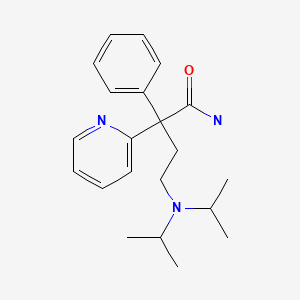CASRN: 3737-09-5

Drug Levels and Effects
Summary of Use during Lactation
Disopyramide is sometimes found in the plasma of nursing infants at levels of 7.5% to 12.5% of the mother's levels. The N-monodesalkyldisopyramide (NMD) metabolite is more anticholinergic than disopyramide itself and appears in breastmilk in levels higher than disopyramide. However, of the cases reported, there are no reports of infant effects. Disopyramide may be used cautiously while breastfeeding when other alternatives are unacceptable. Observe the infant for anticholinergic symptoms. Infant serum concentrations can be monitored if there is any concern about drug-induced adverse effects. Theoretically, disopyramide might decrease the milk supply.
Drug Levels
Maternal Levels. In one report, a maternal dose of 200 mg orally 3 times a day produced milk levels of 2.6 to 5.7 mg/L and N-monodesalkyldisopyramide (NMD) levels of 1.8 to 4.8 mg/L during the days 4 to 17 postpartum.[1]
A maternal disopyramide dose of 100 mg orally 5 times daily resulted in milk levels of 1.4 and 1.7 mg/L 3 hours after a dose on days 2 and 16 postpartum; metabolite levels were not measured.[2] The amounts in milk represent an infant dosage of about 2.5 to 3% of the maternal weight-adjusted dosage.
A mother taking 200 mg of disopyramide twice daily had milk levels of 0.58 mg/L before a dose and 0.98 mg/L at 3.5 hours after a dose.[3] The amounts in milk represent an infant dosage of about 1.3 to 2.2% of the maternal weight-adjusted dosage.
A woman taking 450 mg of disopyramide orally every 8 hours had milk levels of 2.6 to 4.4 mg/L at 0, 2, 4 and 8 hours after the dose, with the highest level reported 4 hours after the dose. Milk N-monodesalkyldisopyramide (NMD) levels ranged from 9.6 to 12.3 mg/L, with the highest level at 2 hours after the dose.[4] The peak disopyramide and NMD levels represent an infant dosage of about 3 and 8% of the maternal weight-adjusted dosages, respectively.
One mother (time postpartum not stated) took a single dose of disopyramide 100 mg orally. The highest milk level was 0.64 mg/L at 3 and 4 hours after the dose. By 12 hours after the dose, the milk level had fallen to 0.11 mg/L. The authors estimated that an exclusively breastfed infant would receive 3% of the maternal weight-adjusted dosage of disopyramide; however, metabolite levels were not measured.[5]
Infant Levels. A mother took disopyramide 200 mg orally 3 times a day. After 28 days of breastfeeding, the infant had a plasma disopyramide level of 0.5 mg/L (about 12.5% of maternal serum level) and no detectable NMD.[1]
The mother of a breastfed infant was taking a disopyramide dose of 100 mg orally 5 times daily. Disopyramide was undetectable (<0.5 mg/L) in the breastfed infant's plasma on days 2 and 16 of age.[2]
A mother was taking 200 mg of disopyramide twice daily. Her 8-week-old breastfed infant had serum disopyramide levels of 0.14 mcg/L before nursing and 0.1 mg/L at 1 and 2.5 hours after nursing. These were about 7.5% of maternal serum levels.[3]
A woman was taking 450 mg of disopyramide orally every 8 hours. Disopyramide was undetectable (<0.45 mg/L) in the infant's serum, but both disopyramide and NMD were detected in the infant's urine.[4]
Effects in Breastfed Infants
There are reports of two infants who were breast-fed without complications during maternal disopyramide use of 500 to 600 mg daily effect.[1,2] Infant symptoms of crying and restlessness after meals thought by one mother to be caused by disopyramide in breastmilk were judged to be unrelated by the examining physicians.[3]
Effects on Lactation and Breastmilk
Relevant published information was not found as of the revision date.
References
- 1.
- Barnett DB, Hudson SA, McBurney A. Disopyramide and its N-monodesalkyl metabolite in breast milk. Br J Clin Pharmacol 1982;14:310-2. [PMC free article: PMC1427749] [PubMed: 7104189]
- 2.
- MacKintosh D, Buchanan N. Excretion of disopyramide in human breast milk. Br J Clin Pharmacol 1985;19:856-7. [PMC free article: PMC1463854] [PubMed: 4027131]
- 3.
- Hoppu K, Neuvonen P, Korte T. Disopyramide and breast feeding. Br J Clin Pharmacol 1986;21:553. [PMC free article: PMC1401040] [PubMed: 3718815]
- 4.
- Ellsworth AJ, Horn JR, Raisys VA, et al. Disopyramide and N-monodesalkyl disopyramide in serum and breast milk. DICP Ann Pharmacother 1989;23:56-7. [PubMed: 2718484]
- 5.
- Wakaumi M, Tsuruoka S, Sakamoto K, et al. Pilsicainide in breast milk from a mother: Comparison with disopyramide and propafenone. Br J Clin Pharmacol 2005;59:120-2. [PMC free article: PMC1884966] [PubMed: 15606453]
Substance Identification
Substance Name
Disopyramide
CAS Registry Number
3737-09-5
Drug Class
Breast Feeding
Lactation
Milk, Human
Antiarrhythmics
Disclaimer: Information presented in this database is not meant as a substitute for professional judgment. You should consult your healthcare provider for breastfeeding advice related to your particular situation. The U.S. government does not warrant or assume any liability or responsibility for the accuracy or completeness of the information on this Site.
Publication Details
Publication History
Last Revision: September 15, 2024.
Copyright
Attribution Statement: LactMed is a registered trademark of the U.S. Department of Health and Human Services.
Publisher
National Institute of Child Health and Human Development, Bethesda (MD)
NLM Citation
Drugs and Lactation Database (LactMed®) [Internet]. Bethesda (MD): National Institute of Child Health and Human Development; 2006-. Disopyramide. [Updated 2024 Sep 15].